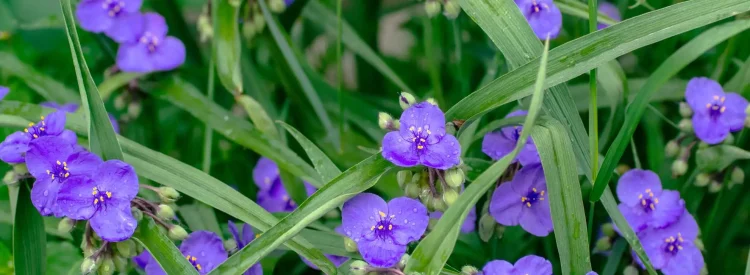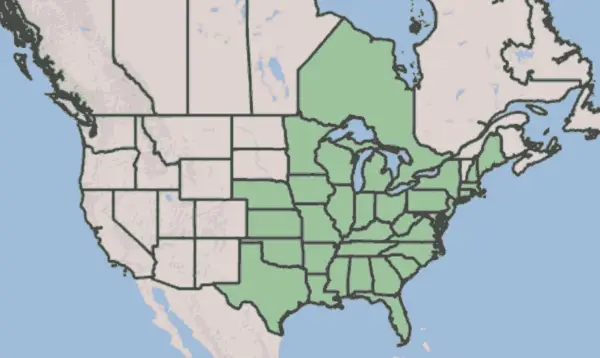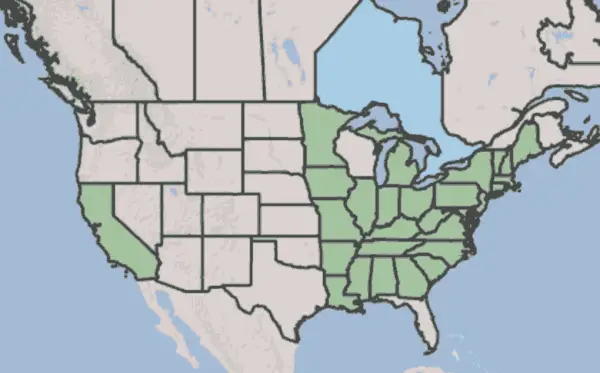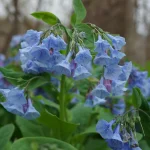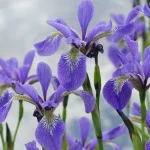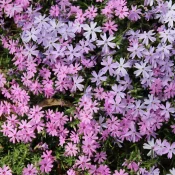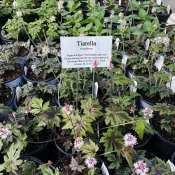Ignore the creepy name. Spiderwort is actually one of the most forgiving, cheerful natives you can grow. It shoots up in spring with grassy leaves and tall stems topped with clusters of blue-purple flowers that bloom for weeks. Each flower lasts just a day, but new ones open daily, giving the plant a long flowering season from spring into early summer. Easy to grow in sun or part sun, clay or loam, dry or moist soils—Spiderwort is the definition of beginner-friendly. Plant it where you’ll see it often, because the flowers are little daily surprises.

Spiderwort is one of those native plants you often see in landscaping and gardens, hiding in plain sight. Its shape looks so similar to that of other non-native plants like daffodils and bulbs that you might think it’s non-native. Surprise! Spiderwort has been growing in North America for thousands of years. In this article, we’ll explore its name, how to grow it, and introduce a few cultivar options.
Let’s start with a basic question:
Is Spiderwort a good choice for my yard?
Yes, if…
- You want early-season blooms that last 4–6 weeks.
- You need a plant that thrives in clay, loam, or less-than-perfect soils.
- You’d like a low-maintenance pollinator favorite.
- You’re looking for something deer-resistant.
Why Spiderwort matters:
There are many benefits to this native flower, including:
- Long bloom-time. Expect 4-6 weeks of flowers from spring to early summer.
- Happy with sun to part sun. This wide range of sunlight makes it perfect for beginner gardeners. (Although the sunnier the spot, the more butterflies you’ll attract.)
- Dry to moist soil. As long as it’s not water-logged, this plant will be happy.
- Loam to clay soil. No stress here—Spiderwort can handle a range of soils.
- Deer-resistant. Deer leave this plant alone!
New to native?
Before lawns and landscaping, native plants were here. They’ve fed birds, bees, and butterflies for thousands of years—and they’ll do the same in your yard. The best part? They’re easier to grow than you think.

Spiderwort is deer-proof
Deer do NOT eat Spiderwort. If you’re worried about deer nibbling your garden, planting Spiderwort is a good native gardening choice.
Where is Spiderwort native?
It depends on the species. At least 10+ Tradesceantia / Spiderwort are native to North America. There are Spiderworts native to just Texas, and other species native to the eastern half of the United States.
Ohio Spiderwort (T. ohiensis) and Virginia Spiderwort (T. virginiana) are the two you’ll most often find at nurseries, both with massive native ranges:
Ohio Spiderwort
Tradescantia ohiensis
Ohio Spiderwort is native to a vast part of North America—from Maine to Texas.
Virginia Spiderwort
Tradescantia virginiana
Virginia Spiderwort is also native to a large part of North America, from Maine to Louisiana and California.
Now you’re probably wondering—which one should I plant? Does it matter?
A better way to ‘pick’ a Spiderwort species is to source plants close to you. Since most Spiderworts look and behave the same, the best thing you can do is find plants with DNA that is best suited for your home area.
Plant ‘provenance’ is a secret advantage for gardens
As you can imagine, a Virginia Spiderwort with a family tree from New Hampshire will have much different DNA than a Spiderwort from Georgia. The area where a plant’s DNA is from is called its provenance.
Provenance takes hundreds or thousands of years to establish. Multiple generations of a plant must grow, cross pollinate, and evolve for the DNA to build resilience and knowledge of its home area.
Use this secret to your advantage and plant the most locally-grown Spiderwort you can—regardless of the species. We’ve made this easy in our Resources section. Find your state’s native plant society, visit native plant nurseries, and buy online from close sources. (Using local sources is one of those ‘tricks’ that professional landscapers use to ensure their work is resilient and beautiful.)
To sum up plant provenance with a silly rhyme (sometimes it helps us remember!)
Plants and seeds grown close to home are tuned to your soil, weather, and pollinators. Stay within 500 miles—or about a day’s drive—to help your garden thrive naturally.
Where Spiderwort shines in your yard
Plant Spiderwort in clusters near paths, fences, or the front of a garden bed where you can enjoy its daily blooms. It looks especially striking in morning sun, when the fresh flowers open. Pair it with later-blooming natives like native asters and black-eyed susans so pollinators always have something to snack on.
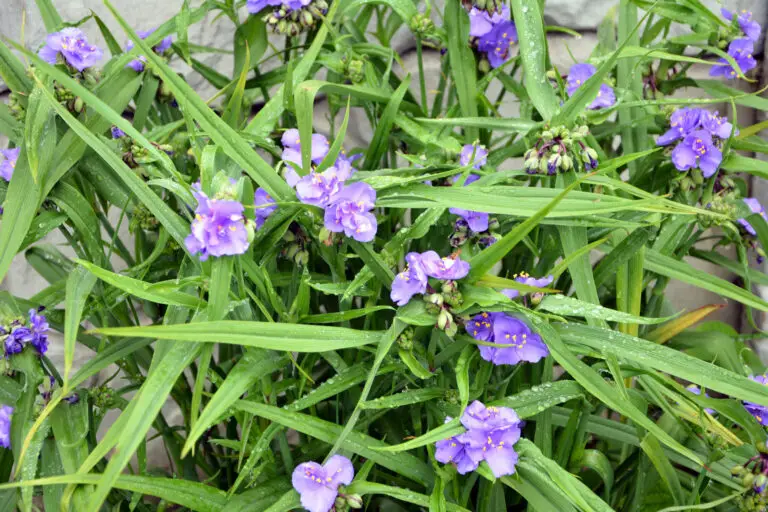
Why is it called Spiderwort?
Spiderwort is one of those names that makes you wonder if early colonists had any imagination at all. This beautiful plant got saddled with a name that sounds creepy and sinister, courtesy of some long-ago copywriter who clearly wasn’t known for creative skills.
The “spider” part comes from what happens when the stem is cut: according to the Missouri Botanical Garden, a “viscous stem secretion is released which becomes threadlike and silky upon hardening (like a spider’s web).”
It’s named for something that no one even sees—unless the plant is cut open.
Thanks for nothing; whoever picked this sad common name! We’ve added Spiderwort to our round-up of Beautiful Native Plants with Terrible Common Names. We strongly believe we should change this plant’s common name to Cobalt Fireworks in our lifetimes.
Spiderwort thrives in almost any environment
It bears repeating that spiderwort thrives in dry or moist soil, loamy (meaning with lots of compostable bits), or clay. It likes full sun to part sun. Because of its forgiving nature, Spiderwort is a perfect plant for beginner gardeners.
If you’ve ever called yourself a ‘Black Thumb’ because of your ability to kill plants, this is a great plant for you. Other easy-going native flower options include coneflowers, bee balm, asters, and many milkweed species.
Spiderwort is a hummingbird and butterfly favorite
Spiderwort flowers are an excellent nectar source for hummingbirds and butterflies. Butterflies love to warm their bodies up in the sun, so planting Spiderwort in sunnier areas will help maximize butterfly sightings.
Speaking of flowers…
Each spiderwort flower bud blooms for a single day. But don’t worry—each flower has so many buds that this singular bloom timing helps the plant appear in flower for weeks.
How to get Spiderwort to flower twice
There are a few native flowers that offer bloom times twice a year (the shade-favorite Celandine Poppy also comes to mind). To get Spiderwort to flower twice:
- Cut the greenery to the ground after the flowers bloom the first time.
- New greenery will reappear, and the plant will start its growing journey again.
- Expect a second flowering in the late summer / early fall.
How does Spiderwort spread?
Spiderwort spreads by sending roots outward and having plants grow up from there—these are called stolons. (This is how strawberries spread, too.) Plant a few Ohio or Virginia Spiderworts and watch them slowly spread in your garden over the years.
To keep them from spreading, dig them up, divide the plant (give the extra plant bits to neighbors and friends!), and replant the smaller pieces.
What are good pairings for Spiderwort?
Pair Spiderwort with native flowers that bloom at other parts of the season, like native penstemons and fall-blooming asters.
And that sums up our profile of Spiderwort! Let’s put this dreadful common name aside and plant this native flower in our gardens. Pair it with flowers that bloom throughout the rest of the summer into fall so that your garden looks amazing and pollinators always have something to snack on. Since Spiderwort is so forgiving of soils—clay, loam—and sunshine—full sun, part sun—it is a perfect native flower for beginner gardeners. Want more fuss-free recommendations? We recommend stopping by our Beginner’s Guide to Native Trees for Front Yards and our Beginner’s Guide to Native Asters. Or go laugh at some other plant naming fails with our Terrible Names, Beautiful Native Plants. Happy planting!
Sources
- Holland, Jonah. Lewis Ginter Botanical Garden, Spiderwort: Why is it called that anyway? June 6, 2014.
- Missouri Botanical Garden, Spiderwort
- USDA Plants Database, Spiderwort
Blue is a rare color in nature! Here are some other options.
What if your feed was actually good for your mental health?
Give your algorithm a breath of fresh air and follow us.
